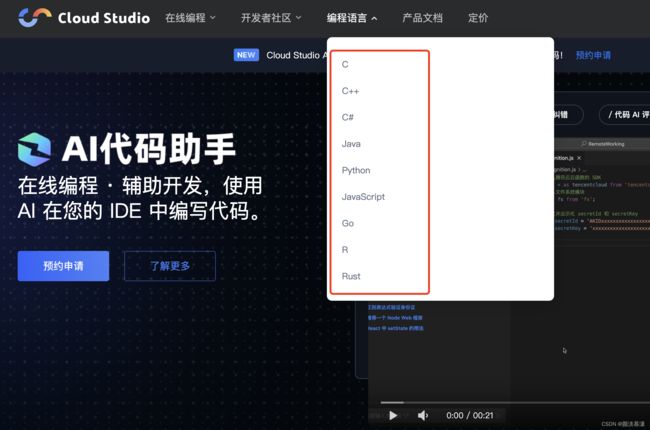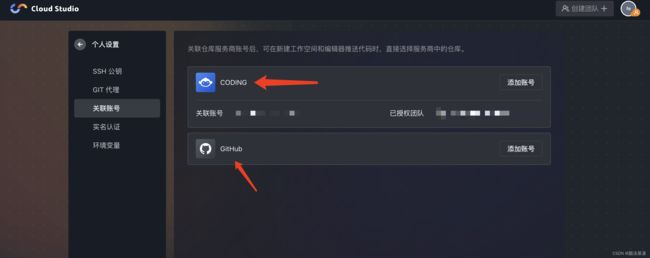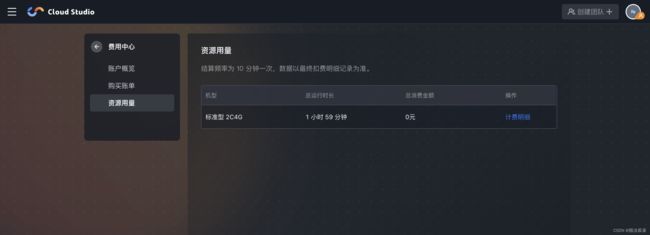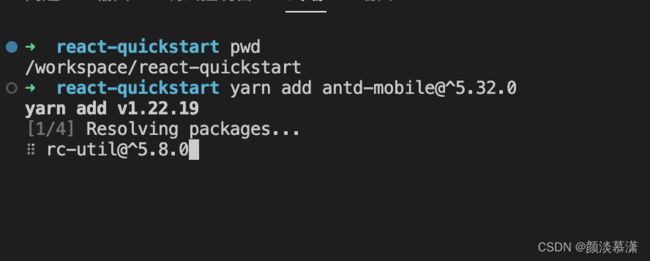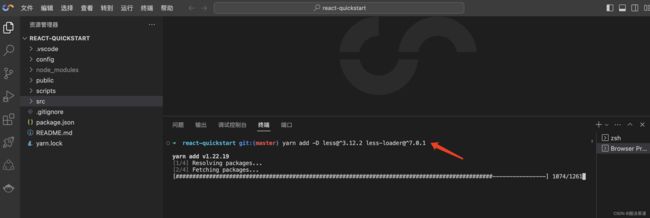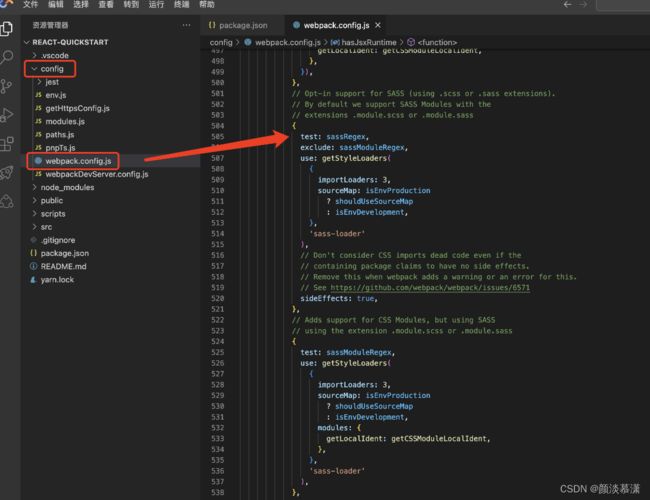【腾讯云】深入解析CloudStudio—React 快速构建点餐页面
序言
运气不会凭空而来,只有当你足够努力的时候,才会足够幸运。
文章标记颜色说明:
- 黄色:重要标题
- 红色:用来标记结论
- 绿色:用来标记论点
- 蓝色:用来标记论点
腾讯云CloudStudio是一款基于云端的集成开发环境(IDE),它可以让开发人员在任何地方、任何时间使用互联网访问和编写代码,而无需安装任何软件或工具。
在本文中,将详细介绍CloudStudio的
- CloudStudio功能特点
- 编辑器功能特点
- 其他功能介绍
- CloudStudio从0到1项目实战
- 总结&展望
希望这篇文章能让你不仅有一定的收获,而且可以愉快的学习,如果有什么建议,都可以留言和我交流
1 功能特点
CloudStudio是一款基于云端的集成开发环境(IDE),它提供了许多先进的特点和功能,可以帮助我们更加高效、灵活地进行软件开发和测试。
下面是CloudStudio的详细特点和功能:
- 多语言支持
- 无需安装
- 云端存储
- 智能编码
- 版本控制
- 丰富的插件生态
- 高度可定制
- 高度安全
- 易于扩展
- 轻量级
官网地址:cloudstudio
1.1 多语言支持
CloudStudio支持多种编程语言和框架。
这意味着我们可以在同一个IDE中进行多种不同语言的开发工作,无需切换到不同的工具或环境。
CloudStudio支持多种编程语言和框架,包括但不限于以下几种:
- Java
- Python
- Node.js
- Kotlin
- Scala
- React
- Vue.js
- Angular
- Ruby
- PHP
除了上述编程语言和框架,CloudStudio还支持其他一些编程语言和框架。
CloudStudio支持多种编程语言和框架,可以满足不同类型的开发人员的需求。
如果需要使用其他编程语言或框架,也可以考虑使用CloudStudio的插件或自定义开发工具来满足对应的需求。
1.2 无需安装
CloudStudio是基于云端的IDE,无需在本地计算机上安装任何软件或工具。我们可以随时随地使用任何设备进行开发,无需担心软件安装和配置的问题。
访问地址:cloudstudio
1.3 云端存储
CloudStudio将代码和项目存储在云端,我们可以在任意设备上访问和编辑代码,无需担心数据丢失或备份。
此外,云端存储还可以帮助开发团队更好地协作和共享代码。
在个人设置有CODING GitHub账号关联设置
1.4 智能编码
CloudStudio内置了智能编码功能,可以提供代码补全、自动修复、重构等功能,帮助我们更加高效地编写代码。
此外,智能编码还可以提高代码的质量和可维护性。
1.5 版本控制
CloudStudio集成了Git版本控制系统,可以帮助我们轻松管理和维护自己的代码库。
我们可以使用Git来跟踪代码的变化、协作开发、管理分支和合并请求等。
1.6 丰富的插件生态
CloudStudio支持第三方插件,可以帮助我们扩展和定制IDE的功能。
这些插件可以提供额外的语言支持、调试器、自动化工具等,使得我们可以根据自己的需求进行个性化的设置。
1.7 高度可定制
CloudStudio提供了许多可定制的选项和设置,可以帮助我们根据自己的需求进行个性化设置,如修改主题、字体、缩进等。
1.8 高度安全
CloudStudio采用了多层安全措施,保障代码和数据的安全性。CloudStudio的数据存储和传输都采用了加密技术,确保数据不被黑客或恶意软件攻击。
1.9 易于扩展
CloudStudio具有可扩展性,可以根据需要添加新的工具、插件和库。开发人员可以使用CloudStudio的API和SDK来创建自己的插件和工具,以满足个性化需求。
1.10轻量级
CloudStudio是一个轻量级的IDE,可以快速启动和运行。这意味着开发人员可以更快地开始编写代码并运行项目,提高开发效率。
总结
总之,CloudStudio是一款功能强大、安全稳定、易于扩展、轻量级的云端IDE,可以帮助我们更好地管理和维护他们的代码。
如果需要高效、灵活开发,CloudStudio是一个值得尝试的工具。
2 编辑器功能特点
以下是CloudStudio的代码编辑器支持的一些主要功能:
- 语法高亮
- 代码自动补全
- 自动缩进
- 多光标编辑
- 代码折叠
- 查找和替换
- 代码导航
- 快速预览
- 代码格式化
2.1 语法高亮
代码编辑器能够根据所使用的编程语言,自动高亮显示不同的语法元素,以帮助我们更好地理解代码结构。
2.2 代码自动补全
当输入代码时,编辑器会智能地提供代码补全建议,以帮助我们更快地编写代码。
这包括关键字、方法名、类名、变量名等。当按下Tab键时,编辑器会自动插入最佳建议。
2.3 自动缩进
代码编辑器会根据我们的编程语言和代码结构自动缩进,以更好地组织代码,并提高代码的可读性。
当然,也支持手动调整缩进。
2.4 多光标编辑
代码编辑器支持多光标编辑,可以同时在多个位置插入或编辑文本。只需按住Ctrl键并单击文本即可创建多个光标。
2.5 代码折叠
代码编辑器支持代码折叠,可以将代码块折叠起来,以便更好地浏览和编辑代码。您只需单击代码行号旁边的折叠图标即可折叠代码块。
2.6 查找和替换
代码编辑器支持查找和替换功能,可以帮助您快速查找并替换代码中的文本。您可以使用快捷键Ctrl+F(查找)和Ctrl+H(替换)。
2.7 代码导航
代码编辑器支持代码导航功能,可以帮助您快速浏览代码文件,并跳转到您需要的代码行。您可以使用快捷键Ctrl+Shift+O来打开文件导航器。
2.8 快速预览
代码编辑器支持快速预览功能,可以让您在不离开编辑器的情况下查看代码文件的内容。
只需单击文件名旁边的查看图标即可。
2.9 代码格式化
代码编辑器支持代码格式化功能,可以自动调整代码缩进、空格和换行等格式,以提高代码的可读性和一致性。
可以使用快捷键Ctrl+Shift+F来格式化代码。
2.10 总结
总之,CloudStudio的代码编辑器是一个功能强大、易于使用的工具,可以帮助您更好地编写、阅读和维护代码。
如果您是一个需要高效、准确编码的开发人员,CloudStudio的代码编辑器是您的最佳选择。
3 其他功能
3.1 个人设置
个人设置包括:
- SSH公钥
- GIT代理
- 关联账号
- 实名认证
- 环境变量
如下图示例,可根据自己的需要进行设置
GIT代理
关联账号
3.2 费用中心
费用中心包括三个模块:
- 账户概览
- 购买账单
- 资源用量
这个模块主要是查看自己在平台的费用使用以及资源相关内容
进入费用中心
点击账号下面这个图标,就可以进入费用中心
账户概览
资源用量
4 项目实战
这个项目会用云 IDE Cloud Studio 快速搭建,并开发还原一个移动端 React H5 的简版点餐系统页面。
从 0 到 1 体验云 Cloud Studio 给项目带来的优势。
4.1 注册账号
打开官方链接,注册可以使用三种方式:
- CODEING
- 微信
- GitHub
我选择的是CODEING,需要先输入coding域名,
输入域名之后,进入下界面 ,选择你的coding账号方式,进行扫码。
如果你没有coding账号,需要先去注册一个,然后再进行登录。
coding官网地址:coding
4.2 登录成功
扫码之后,正产情况就会成功登录,界面如下 ,这里可以看到提供了很多模板:
- 常用模板
- 框架模板
- 云原生模板
- 建站模板
可以根据自己的需求,选择对应的模板。
4.3 框架初始化
1. 选择框架模板
因为这个项目使用的是React框架,所以我们可以选择这个框架,创建工作空间
2 创建工作空间
3 代码初始化
空间启动成功中行,可以看到初始化左侧代码后,控制台会安装依赖及启动一个 React 简单的模板项目。
4. 项目启动
在项目当前目录下,执行项目启动,执行之后,可看到下图,则说明项目初始化成功
yarn yarn start
4.4 安装依赖
下面进行相关依赖安装
1. 安装 antd-mobile
安装命令
yarn add antd-mobile@^5.32.0安装成功
2. 安装 Less
安装命令
yarn add -D less@^3.12.2 less-loader@^7.0.1
安装成功
3 修改webpack 配置文件
执行命令
yarn eject
输入 'y' 后,项目会自动进行解构操作。
完成命令之后,项目根目录会出现一个config文件夹,里面是一些配置相关的脚本,也可以看到 package.json 中多了很多属性值,如 "dependencies".
操作完成,会看到如下图:
4.5 代码修改
找到 config/webpack.config.js 文件,找到第60行左右,这块是设置 css 相关的代码。
增加less配置:可以复制一下sass的代码,改为less
// style files regexes
const cssRegex = /\.css$/;
const cssModuleRegex = /\.module\.css$/;
const sassRegex = /\.(scss|sass)$/;
const sassModuleRegex = /\.module\.(scss|sass)$/;
// 新增加 Less 代码
const lessRegex = /\.(less)$/;
const lessModuleRegex = /\.module\.(less)$/;继续向下搜索sass,位置在 504 行左右,能够找到以下代码。
和之前配置一样,仿照sass的配置,进行less的配置。
// less
{
test: lessRegex, // 有改动
exclude: lessModuleRegex, // 有改动
use: getStyleLoaders(
{
importLoaders: 3,
sourceMap: isEnvProduction
? shouldUseSourceMap
: isEnvDevelopment,
},
'less-loader' // 有改动
),
sideEffects: true,
},
{
test: lessModuleRegex, // 有改动
use: getStyleLoaders(
{
importLoaders: 3,
sourceMap: isEnvProduction
? shouldUseSourceMap
: isEnvDevelopment,
modules: {
getLocalIdent: getCSSModuleLocalIdent,
},
},
'less-loader' // 有改动
),
},webpack.config.js 完整代码
复制下面代码可以直接替换webpack.config.js
'use strict';
const fs = require('fs');
const path = require('path');
const webpack = require('webpack');
const resolve = require('resolve');
const HtmlWebpackPlugin = require('html-webpack-plugin');
const CaseSensitivePathsPlugin = require('case-sensitive-paths-webpack-plugin');
const InlineChunkHtmlPlugin = require('react-dev-utils/InlineChunkHtmlPlugin');
const TerserPlugin = require('terser-webpack-plugin');
const MiniCssExtractPlugin = require('mini-css-extract-plugin');
const CssMinimizerPlugin = require('css-minimizer-webpack-plugin');
const { WebpackManifestPlugin } = require('webpack-manifest-plugin');
const InterpolateHtmlPlugin = require('react-dev-utils/InterpolateHtmlPlugin');
const WorkboxWebpackPlugin = require('workbox-webpack-plugin');
const ModuleScopePlugin = require('react-dev-utils/ModuleScopePlugin');
const getCSSModuleLocalIdent = require('react-dev-utils/getCSSModuleLocalIdent');
const ESLintPlugin = require('eslint-webpack-plugin');
const paths = require('./paths');
const modules = require('./modules');
const getClientEnvironment = require('./env');
const ModuleNotFoundPlugin = require('react-dev-utils/ModuleNotFoundPlugin');
const ForkTsCheckerWebpackPlugin =
process.env.TSC_COMPILE_ON_ERROR === 'true'
? require('react-dev-utils/ForkTsCheckerWarningWebpackPlugin')
: require('react-dev-utils/ForkTsCheckerWebpackPlugin');
const ReactRefreshWebpackPlugin = require('@pmmmwh/react-refresh-webpack-plugin');
const createEnvironmentHash = require('./webpack/persistentCache/createEnvironmentHash');
// Source maps are resource heavy and can cause out of memory issue for large source files.
const shouldUseSourceMap = process.env.GENERATE_SOURCEMAP !== 'false';
const reactRefreshRuntimeEntry = require.resolve('react-refresh/runtime');
const reactRefreshWebpackPluginRuntimeEntry = require.resolve(
'@pmmmwh/react-refresh-webpack-plugin'
);
const babelRuntimeEntry = require.resolve('babel-preset-react-app');
const babelRuntimeEntryHelpers = require.resolve(
'@babel/runtime/helpers/esm/assertThisInitialized',
{ paths: [babelRuntimeEntry] }
);
const babelRuntimeRegenerator = require.resolve('@babel/runtime/regenerator', {
paths: [babelRuntimeEntry],
});
// Some apps do not need the benefits of saving a web request, so not inlining the chunk
// makes for a smoother build process.
const shouldInlineRuntimeChunk = process.env.INLINE_RUNTIME_CHUNK !== 'false';
const emitErrorsAsWarnings = process.env.ESLINT_NO_DEV_ERRORS === 'true';
const disableESLintPlugin = process.env.DISABLE_ESLINT_PLUGIN === 'true';
const imageInlineSizeLimit = parseInt(
process.env.IMAGE_INLINE_SIZE_LIMIT || '10000'
);
// Check if TypeScript is setup
const useTypeScript = fs.existsSync(paths.appTsConfig);
// Check if Tailwind config exists
const useTailwind = fs.existsSync(
path.join(paths.appPath, 'tailwind.config.js')
);
// Get the path to the uncompiled service worker (if it exists).
const swSrc = paths.swSrc;
// style files regexes
const cssRegex = /\.css$/;
const cssModuleRegex = /\.module\.css$/;
const sassRegex = /\.(scss|sass)$/;
const sassModuleRegex = /\.module\.(scss|sass)$/;
const lessRegex = /\.less$/;
const lessModuleRegex = /\.module\.less$/;
const hasJsxRuntime = (() => {
if (process.env.DISABLE_NEW_JSX_TRANSFORM === 'true') {
return false;
}
try {
require.resolve('react/jsx-runtime');
return true;
} catch (e) {
return false;
}
})();
// This is the production and development configuration.
// It is focused on developer experience, fast rebuilds, and a minimal bundle.
module.exports = function (webpackEnv) {
const isEnvDevelopment = webpackEnv === 'development';
const isEnvProduction = webpackEnv === 'production';
// Variable used for enabling profiling in Production
// passed into alias object. Uses a flag if passed into the build command
const isEnvProductionProfile =
isEnvProduction && process.argv.includes('--profile');
// We will provide `paths.publicUrlOrPath` to our app
// as %PUBLIC_URL% in `index.html` and `process.env.PUBLIC_URL` in JavaScript.
// Omit trailing slash as %PUBLIC_URL%/xyz looks better than %PUBLIC_URL%xyz.
// Get environment variables to inject into our app.
const env = getClientEnvironment(paths.publicUrlOrPath.slice(0, -1));
const shouldUseReactRefresh = env.raw.FAST_REFRESH;
// common function to get style loaders
const getStyleLoaders = (cssOptions, preProcessor) => {
const loaders = [
isEnvDevelopment && require.resolve('style-loader'),
isEnvProduction && {
loader: MiniCssExtractPlugin.loader,
// css is located in `static/css`, use '../../' to locate index.html folder
// in production `paths.publicUrlOrPath` can be a relative path
options: paths.publicUrlOrPath.startsWith('.')
? { publicPath: '../../' }
: {},
},
{
loader: require.resolve('css-loader'),
options: cssOptions,
},
{
// Options for PostCSS as we reference these options twice
// Adds vendor prefixing based on your specified browser support in
// package.json
loader: require.resolve('postcss-loader'),
options: {
postcssOptions: {
// Necessary for external CSS imports to work
// https://github.com/facebook/create-react-app/issues/2677
ident: 'postcss',
config: false,
plugins: !useTailwind
? [
'postcss-flexbugs-fixes',
[
'postcss-preset-env',
{
autoprefixer: {
flexbox: 'no-2009',
},
stage: 3,
},
],
// Adds PostCSS Normalize as the reset css with default options,
// so that it honors browserslist config in package.json
// which in turn let's users customize the target behavior as per their needs.
'postcss-normalize',
]
: [
'tailwindcss',
'postcss-flexbugs-fixes',
[
'postcss-preset-env',
{
autoprefixer: {
flexbox: 'no-2009',
},
stage: 3,
},
],
],
},
sourceMap: isEnvProduction ? shouldUseSourceMap : isEnvDevelopment,
},
},
].filter(Boolean);
if (preProcessor) {
loaders.push(
{
loader: require.resolve('resolve-url-loader'),
options: {
sourceMap: isEnvProduction ? shouldUseSourceMap : isEnvDevelopment,
root: paths.appSrc,
},
},
{
loader: require.resolve(preProcessor),
options: {
sourceMap: true,
},
}
);
}
return loaders;
};
return {
target: ['browserslist'],
// Webpack noise constrained to errors and warnings
stats: 'errors-warnings',
mode: isEnvProduction ? 'production' : isEnvDevelopment && 'development',
// Stop compilation early in production
bail: isEnvProduction,
devtool: isEnvProduction
? shouldUseSourceMap
? 'source-map'
: false
: isEnvDevelopment && 'cheap-module-source-map',
// These are the "entry points" to our application.
// This means they will be the "root" imports that are included in JS bundle.
entry: paths.appIndexJs,
output: {
// The build folder.
path: paths.appBuild,
// Add /* filename */ comments to generated require()s in the output.
pathinfo: isEnvDevelopment,
// There will be one main bundle, and one file per asynchronous chunk.
// In development, it does not produce real files.
filename: isEnvProduction
? 'static/js/[name].[contenthash:8].js'
: isEnvDevelopment && 'static/js/bundle.js',
// There are also additional JS chunk files if you use code splitting.
chunkFilename: isEnvProduction
? 'static/js/[name].[contenthash:8].chunk.js'
: isEnvDevelopment && 'static/js/[name].chunk.js',
assetModuleFilename: 'static/media/[name].[hash][ext]',
// webpack uses `publicPath` to determine where the app is being served from.
// It requires a trailing slash, or the file assets will get an incorrect path.
// We inferred the "public path" (such as / or /my-project) from homepage.
publicPath: paths.publicUrlOrPath,
// Point sourcemap entries to original disk location (format as URL on Windows)
devtoolModuleFilenameTemplate: isEnvProduction
? info =>
path
.relative(paths.appSrc, info.absoluteResourcePath)
.replace(/\\/g, '/')
: isEnvDevelopment &&
(info => path.resolve(info.absoluteResourcePath).replace(/\\/g, '/')),
},
cache: {
type: 'filesystem',
version: createEnvironmentHash(env.raw),
cacheDirectory: paths.appWebpackCache,
store: 'pack',
buildDependencies: {
defaultWebpack: ['webpack/lib/'],
config: [__filename],
tsconfig: [paths.appTsConfig, paths.appJsConfig].filter(f =>
fs.existsSync(f)
),
},
},
infrastructureLogging: {
level: 'none',
},
optimization: {
minimize: isEnvProduction,
minimizer: [
// This is only used in production mode
new TerserPlugin({
terserOptions: {
parse: {
// We want terser to parse ecma 8 code. However, we don't want it
// to apply any minification steps that turns valid ecma 5 code
// into invalid ecma 5 code. This is why the 'compress' and 'output'
// sections only apply transformations that are ecma 5 safe
// https://github.com/facebook/create-react-app/pull/4234
ecma: 8,
},
compress: {
ecma: 5,
warnings: false,
// Disabled because of an issue with Uglify breaking seemingly valid code:
// https://github.com/facebook/create-react-app/issues/2376
// Pending further investigation:
// https://github.com/mishoo/UglifyJS2/issues/2011
comparisons: false,
// Disabled because of an issue with Terser breaking valid code:
// https://github.com/facebook/create-react-app/issues/5250
// Pending further investigation:
// https://github.com/terser-js/terser/issues/120
inline: 2,
},
mangle: {
safari10: true,
},
// Added for profiling in devtools
keep_classnames: isEnvProductionProfile,
keep_fnames: isEnvProductionProfile,
output: {
ecma: 5,
comments: false,
// Turned on because emoji and regex is not minified properly using default
// https://github.com/facebook/create-react-app/issues/2488
ascii_only: true,
},
},
}),
// This is only used in production mode
new CssMinimizerPlugin(),
],
},
resolve: {
// This allows you to set a fallback for where webpack should look for modules.
// We placed these paths second because we want `node_modules` to "win"
// if there are any conflicts. This matches Node resolution mechanism.
// https://github.com/facebook/create-react-app/issues/253
modules: ['node_modules', paths.appNodeModules].concat(
modules.additionalModulePaths || []
),
// These are the reasonable defaults supported by the Node ecosystem.
// We also include JSX as a common component filename extension to support
// some tools, although we do not recommend using it, see:
// https://github.com/facebook/create-react-app/issues/290
// `web` extension prefixes have been added for better support
// for React Native Web.
extensions: paths.moduleFileExtensions
.map(ext => `.${ext}`)
.filter(ext => useTypeScript || !ext.includes('ts')),
alias: {
// Support React Native Web
// https://www.smashingmagazine.com/2016/08/a-glimpse-into-the-future-with-react-native-for-web/
'react-native': 'react-native-web',
// Allows for better profiling with ReactDevTools
...(isEnvProductionProfile && {
'react-dom$': 'react-dom/profiling',
'scheduler/tracing': 'scheduler/tracing-profiling',
}),
...(modules.webpackAliases || {}),
},
plugins: [
// Prevents users from importing files from outside of src/ (or node_modules/).
// This often causes confusion because we only process files within src/ with babel.
// To fix this, we prevent you from importing files out of src/ -- if you'd like to,
// please link the files into your node_modules/ and let module-resolution kick in.
// Make sure your source files are compiled, as they will not be processed in any way.
new ModuleScopePlugin(paths.appSrc, [
paths.appPackageJson,
reactRefreshRuntimeEntry,
reactRefreshWebpackPluginRuntimeEntry,
babelRuntimeEntry,
babelRuntimeEntryHelpers,
babelRuntimeRegenerator,
]),
],
},
module: {
strictExportPresence: true,
rules: [
// Handle node_modules packages that contain sourcemaps
shouldUseSourceMap && {
enforce: 'pre',
exclude: /@babel(?:\/|\\{1,2})runtime/,
test: /\.(js|mjs|jsx|ts|tsx|css)$/,
loader: require.resolve('source-map-loader'),
},
{
// "oneOf" will traverse all following loaders until one will
// match the requirements. When no loader matches it will fall
// back to the "file" loader at the end of the loader list.
oneOf: [
// TODO: Merge this config once `image/avif` is in the mime-db
// https://github.com/jshttp/mime-db
{
test: [/\.avif$/],
type: 'asset',
mimetype: 'image/avif',
parser: {
dataUrlCondition: {
maxSize: imageInlineSizeLimit,
},
},
},
// "url" loader works like "file" loader except that it embeds assets
// smaller than specified limit in bytes as data URLs to avoid requests.
// A missing `test` is equivalent to a match.
{
test: [/\.bmp$/, /\.gif$/, /\.jpe?g$/, /\.png$/],
type: 'asset',
parser: {
dataUrlCondition: {
maxSize: imageInlineSizeLimit,
},
},
},
{
test: /\.svg$/,
use: [
{
loader: require.resolve('@svgr/webpack'),
options: {
prettier: false,
svgo: false,
svgoConfig: {
plugins: [{ removeViewBox: false }],
},
titleProp: true,
ref: true,
},
},
{
loader: require.resolve('file-loader'),
options: {
name: 'static/media/[name].[hash].[ext]',
},
},
],
issuer: {
and: [/\.(ts|tsx|js|jsx|md|mdx)$/],
},
},
// Process application JS with Babel.
// The preset includes JSX, Flow, TypeScript, and some ESnext features.
{
test: /\.(js|mjs|jsx|ts|tsx)$/,
include: paths.appSrc,
loader: require.resolve('babel-loader'),
options: {
customize: require.resolve(
'babel-preset-react-app/webpack-overrides'
),
presets: [
[
require.resolve('babel-preset-react-app'),
{
runtime: hasJsxRuntime ? 'automatic' : 'classic',
},
],
],
plugins: [
isEnvDevelopment &&
shouldUseReactRefresh &&
require.resolve('react-refresh/babel'),
].filter(Boolean),
// This is a feature of `babel-loader` for webpack (not Babel itself).
// It enables caching results in ./node_modules/.cache/babel-loader/
// directory for faster rebuilds.
cacheDirectory: true,
// See #6846 for context on why cacheCompression is disabled
cacheCompression: false,
compact: isEnvProduction,
},
},
// Process any JS outside of the app with Babel.
// Unlike the application JS, we only compile the standard ES features.
{
test: /\.(js|mjs)$/,
exclude: /@babel(?:\/|\\{1,2})runtime/,
loader: require.resolve('babel-loader'),
options: {
babelrc: false,
configFile: false,
compact: false,
presets: [
[
require.resolve('babel-preset-react-app/dependencies'),
{ helpers: true },
],
],
cacheDirectory: true,
// See #6846 for context on why cacheCompression is disabled
cacheCompression: false,
// Babel sourcemaps are needed for debugging into node_modules
// code. Without the options below, debuggers like VSCode
// show incorrect code and set breakpoints on the wrong lines.
sourceMaps: shouldUseSourceMap,
inputSourceMap: shouldUseSourceMap,
},
},
// "postcss" loader applies autoprefixer to our CSS.
// "css" loader resolves paths in CSS and adds assets as dependencies.
// "style" loader turns CSS into JS modules that inject 
